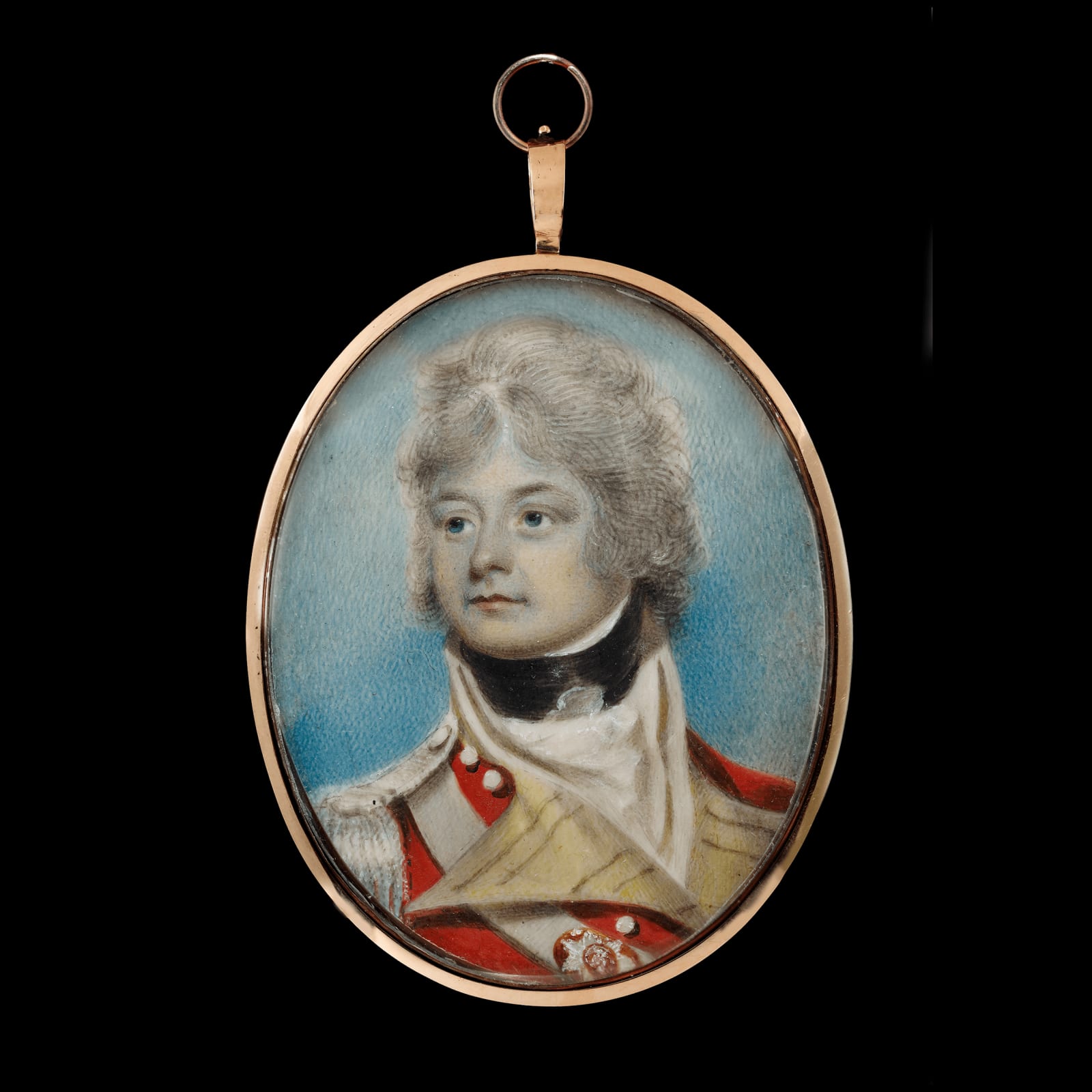
Charles Shirreff
An Officer, wearing the uniform of the 34th (Cumberland) Regiment of Foot, his scarlet coat with yellow facings, silver epaulette and cross belt with regimental badge, 1803
Watercolour and bodycolour on ivory
Oval, 2 3/4 in. (70 mm) high
Philip Mould & Co.
To view all current artworks for sale visit philipmould.com
This portrait by Charles Shirreff shows an unknown sitter in the uniform of the 34th(Cumberland) Regiment of Foot. In 1803, around the time this miniature was painted, the regiment was in Madras, India, where the artist Shirreff worked from 1797. The 1stBattalion was stationed in India up until 1823.
As one of the many artists seeking his fortune in India, Shirreff had the additional disadvantage of being deaf, stating on his application to travel that he had lost his hearing at the age of four, but could communicate through the use of signs.Shirreff was born to the family of a wealthy wine merchant in South Leith Edinburgh. When he was around ten years old, his father sought an education for him with Thomas Braidwood, the owner of a school of mathematics in Edinburgh. Taking on the task to teach the boy to write, Braidwood found he relished the challenge and devised hand gestures which today are recognised as sign language. Soon afterward, Braidwood founded Braidwood's Academy for the Deaf and Dumb, the first school of its kind in Britain.
From this education, Charles was able to launch himself into London’s fiercely competitive art world. In 1769, aged 18, he left the security of Braidwood’s Academy to join the Royal Academy Schools in London. Here, his talent was recognised in the form of a silver medal when he graduated in 1772. Just a few years later he applied to undertake the perilous journey to India, where he joined other portrait painters in making money from the European community who had settled there. After a successful career spanning almost twelve years, Shirreff returned to London in 1808/09 and finally retired to Bath where he spent the last years of his life.
This portrait by Charles Shirreff shows an unknown sitter in the uniform of the 34th(Cumberland) Regiment of Foot. In 1803, around the time this miniature was painted, the regiment was in Madras, India, where the artist Shirreff worked from 1797. The 1stBattalion was stationed in India up until 1823.
As one of the many artists seeking his fortune in India, Shirreff had the additional disadvantage of being deaf, stating on his application to travel that he had lost his hearing at the age of four, but could communicate through the use of signs.Shirreff was born to the family of a wealthy wine merchant in South Leith Edinburgh. When he was around ten years old, his father sought an education for him with Thomas Braidwood, the owner of a school of mathematics in Edinburgh. Taking on the task to teach the boy to write, Braidwood found he relished the challenge and devised hand gestures which today are recognised as sign language. Soon afterward, Braidwood founded Braidwood's Academy for the Deaf and Dumb, the first school of its kind in Britain.
From this education, Charles was able to launch himself into London’s fiercely competitive art world. In 1769, aged 18, he left the security of Braidwood’s Academy to join the Royal Academy Schools in London. Here, his talent was recognised in the form of a silver medal when he graduated in 1772. Just a few years later he applied to undertake the perilous journey to India, where he joined other portrait painters in making money from the European community who had settled there. After a successful career spanning almost twelve years, Shirreff returned to London in 1808/09 and finally retired to Bath where he spent the last years of his life.
Be the first to hear about our available artworks
* denotes required fields
We will process the personal data you have supplied in accordance with our privacy policy (available on request). You can unsubscribe or change your preferences at any time by clicking the link in our emails.